Intercultural Communication Challenges and Recommendations for BeautyPro Company in China
VerifiedAdded on 2023/06/04
|14
|1572
|442
AI Summary
This report discusses the intercultural challenges facing BeautyPro Company in China and offers practical solutions. It identifies different cultural values and etiquette, direct versus indirect styles of communication, and different cultural norms of decision-making as the main challenges. The report recommends ways to overcome these problems and improve communication efficiency. The success or failure of the recommendations can be measured using various methods such as the semantic differentiating method and the preference, practice, and effectiveness of the decision-making style employed.
Contribute Materials
Your contribution can guide someone’s learning journey. Share your
documents today.
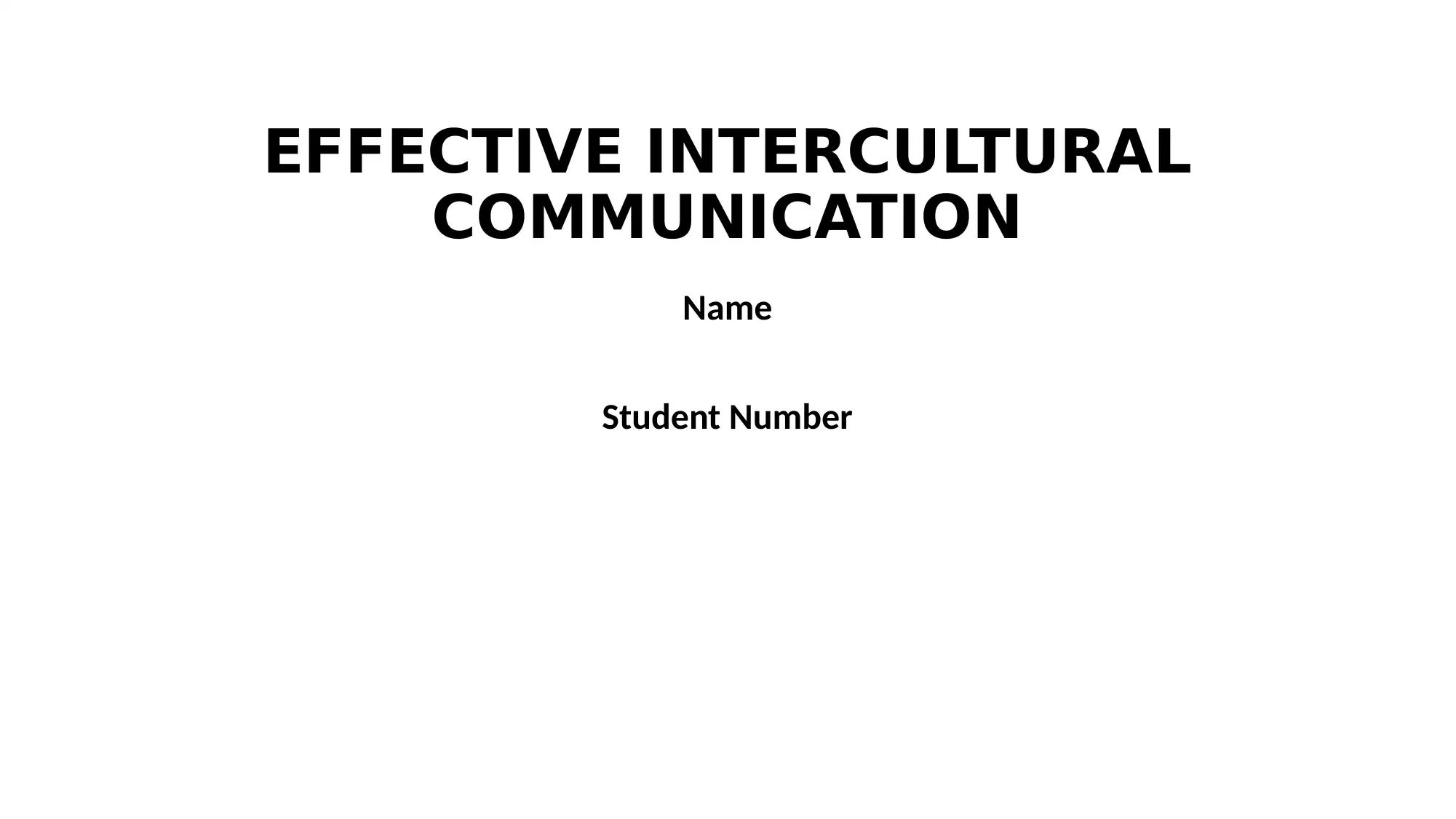
EFFECTIVE INTERCULTURAL
COMMUNICATION
Name
Student Number
COMMUNICATION
Name
Student Number
Secure Best Marks with AI Grader
Need help grading? Try our AI Grader for instant feedback on your assignments.
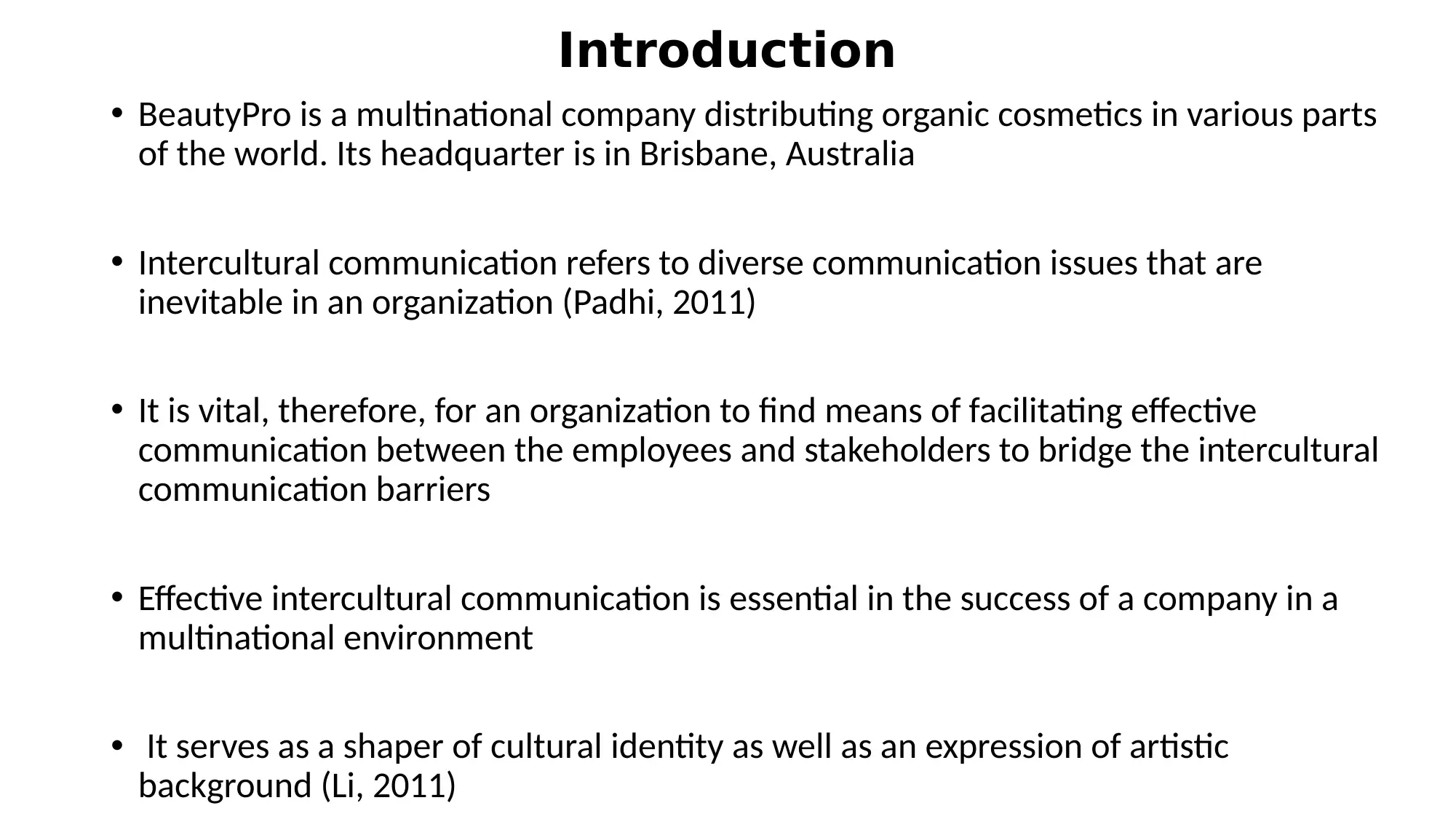
Introduction
• BeautyPro is a multinational company distributing organic cosmetics in various parts
of the world. Its headquarter is in Brisbane, Australia
• Intercultural communication refers to diverse communication issues that are
inevitable in an organization (Padhi, 2011)
• It is vital, therefore, for an organization to find means of facilitating effective
communication between the employees and stakeholders to bridge the intercultural
communication barriers
• Effective intercultural communication is essential in the success of a company in a
multinational environment
• It serves as a shaper of cultural identity as well as an expression of artistic
background (Li, 2011)
• BeautyPro is a multinational company distributing organic cosmetics in various parts
of the world. Its headquarter is in Brisbane, Australia
• Intercultural communication refers to diverse communication issues that are
inevitable in an organization (Padhi, 2011)
• It is vital, therefore, for an organization to find means of facilitating effective
communication between the employees and stakeholders to bridge the intercultural
communication barriers
• Effective intercultural communication is essential in the success of a company in a
multinational environment
• It serves as a shaper of cultural identity as well as an expression of artistic
background (Li, 2011)
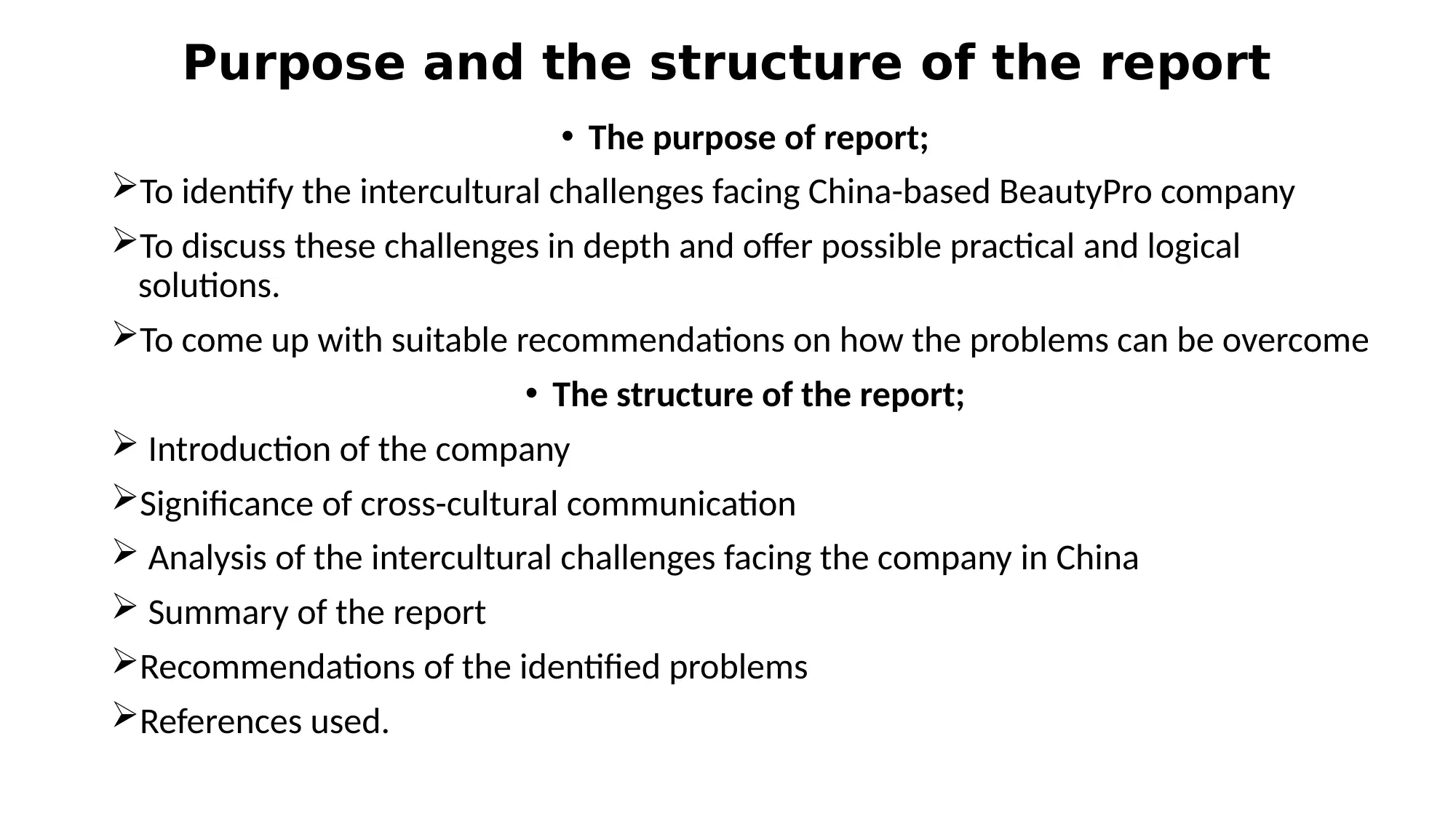
Purpose and the structure of the report
• The purpose of report;
To identify the intercultural challenges facing China-based BeautyPro company
To discuss these challenges in depth and offer possible practical and logical
solutions.
To come up with suitable recommendations on how the problems can be overcome
• The structure of the report;
Introduction of the company
Significance of cross-cultural communication
Analysis of the intercultural challenges facing the company in China
Summary of the report
Recommendations of the identified problems
References used.
• The purpose of report;
To identify the intercultural challenges facing China-based BeautyPro company
To discuss these challenges in depth and offer possible practical and logical
solutions.
To come up with suitable recommendations on how the problems can be overcome
• The structure of the report;
Introduction of the company
Significance of cross-cultural communication
Analysis of the intercultural challenges facing the company in China
Summary of the report
Recommendations of the identified problems
References used.
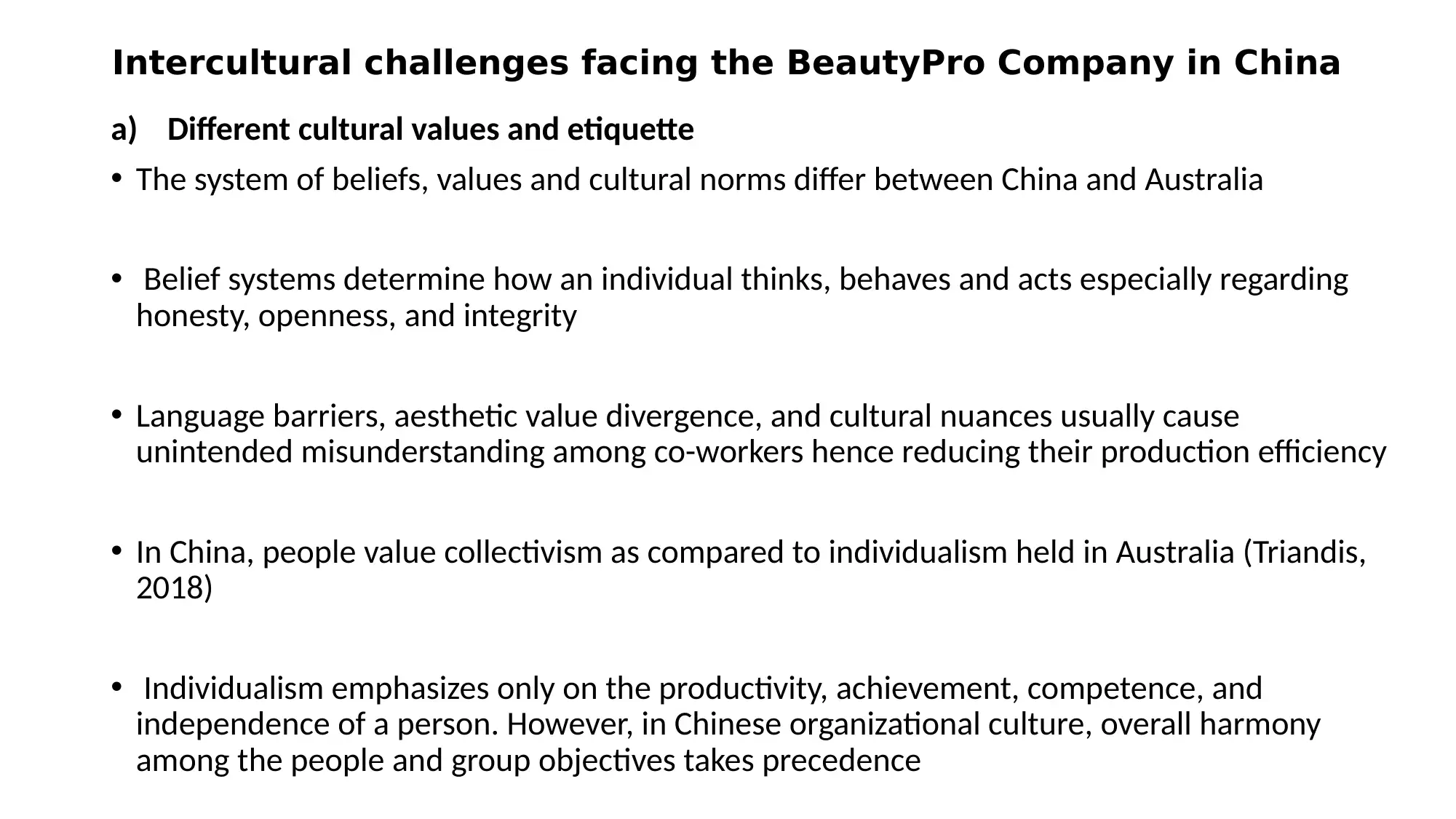
Intercultural challenges facing the BeautyPro Company in China
a) Different cultural values and etiquette
• The system of beliefs, values and cultural norms differ between China and Australia
• Belief systems determine how an individual thinks, behaves and acts especially regarding
honesty, openness, and integrity
• Language barriers, aesthetic value divergence, and cultural nuances usually cause
unintended misunderstanding among co-workers hence reducing their production efficiency
• In China, people value collectivism as compared to individualism held in Australia (Triandis,
2018)
• Individualism emphasizes only on the productivity, achievement, competence, and
independence of a person. However, in Chinese organizational culture, overall harmony
among the people and group objectives takes precedence
a) Different cultural values and etiquette
• The system of beliefs, values and cultural norms differ between China and Australia
• Belief systems determine how an individual thinks, behaves and acts especially regarding
honesty, openness, and integrity
• Language barriers, aesthetic value divergence, and cultural nuances usually cause
unintended misunderstanding among co-workers hence reducing their production efficiency
• In China, people value collectivism as compared to individualism held in Australia (Triandis,
2018)
• Individualism emphasizes only on the productivity, achievement, competence, and
independence of a person. However, in Chinese organizational culture, overall harmony
among the people and group objectives takes precedence
Secure Best Marks with AI Grader
Need help grading? Try our AI Grader for instant feedback on your assignments.
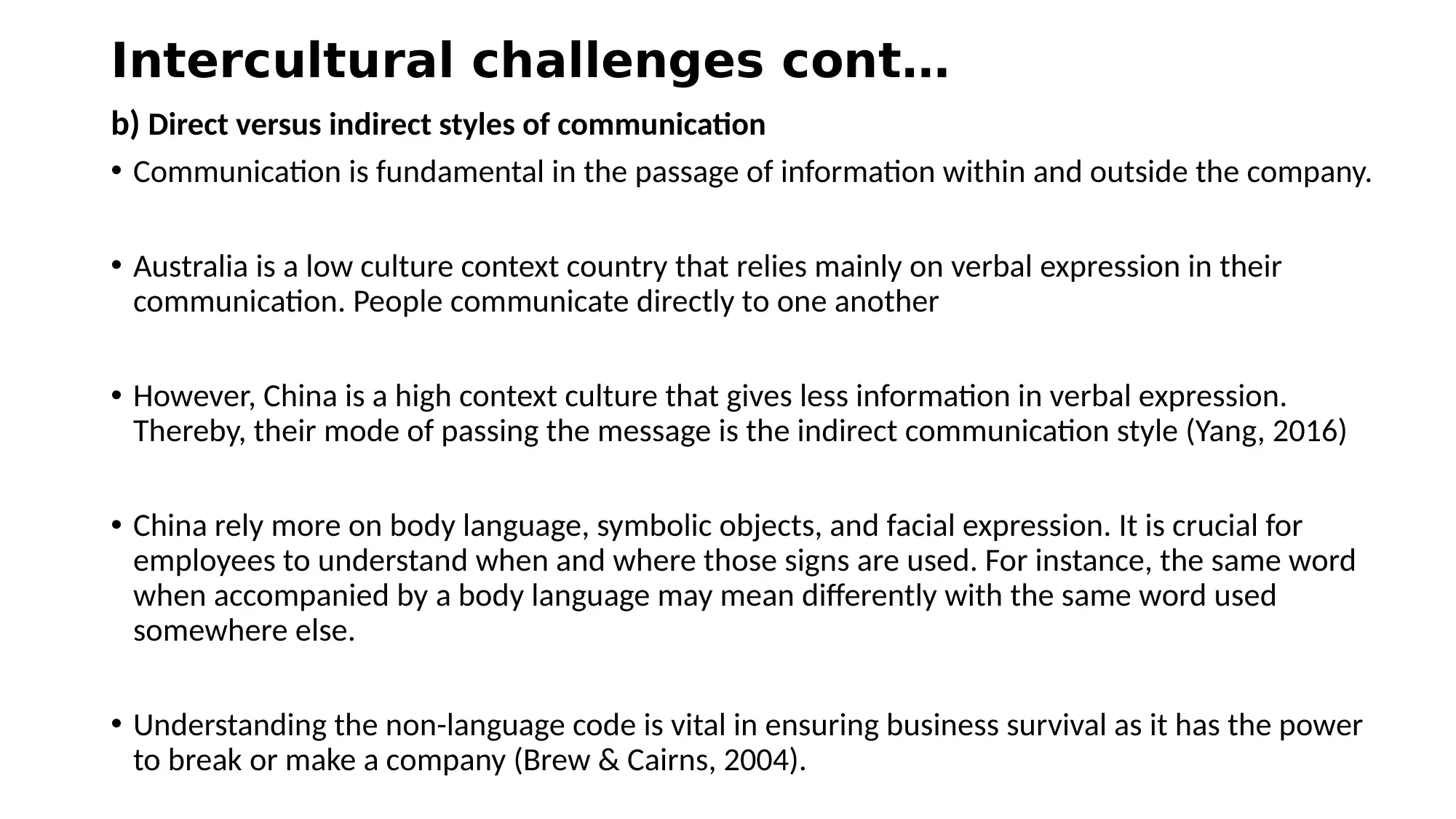
Intercultural challenges cont…
b) Direct versus indirect styles of communication
• Communication is fundamental in the passage of information within and outside the company.
• Australia is a low culture context country that relies mainly on verbal expression in their
communication. People communicate directly to one another
• However, China is a high context culture that gives less information in verbal expression.
Thereby, their mode of passing the message is the indirect communication style (Yang, 2016)
• China rely more on body language, symbolic objects, and facial expression. It is crucial for
employees to understand when and where those signs are used. For instance, the same word
when accompanied by a body language may mean differently with the same word used
somewhere else.
• Understanding the non-language code is vital in ensuring business survival as it has the power
to break or make a company (Brew & Cairns, 2004).
b) Direct versus indirect styles of communication
• Communication is fundamental in the passage of information within and outside the company.
• Australia is a low culture context country that relies mainly on verbal expression in their
communication. People communicate directly to one another
• However, China is a high context culture that gives less information in verbal expression.
Thereby, their mode of passing the message is the indirect communication style (Yang, 2016)
• China rely more on body language, symbolic objects, and facial expression. It is crucial for
employees to understand when and where those signs are used. For instance, the same word
when accompanied by a body language may mean differently with the same word used
somewhere else.
• Understanding the non-language code is vital in ensuring business survival as it has the power
to break or make a company (Brew & Cairns, 2004).
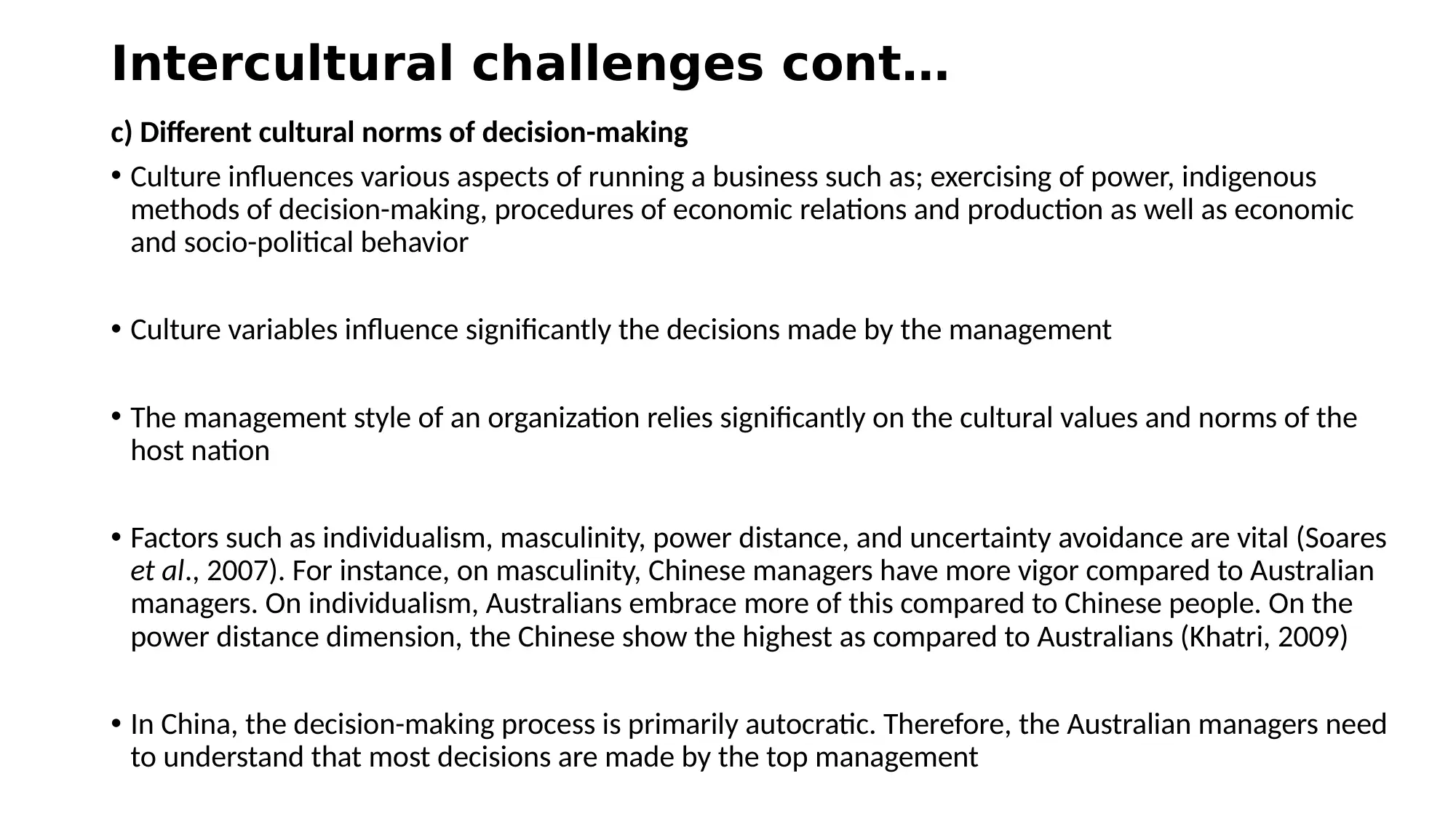
Intercultural challenges cont…
c) Different cultural norms of decision-making
• Culture influences various aspects of running a business such as; exercising of power, indigenous
methods of decision-making, procedures of economic relations and production as well as economic
and socio-political behavior
• Culture variables influence significantly the decisions made by the management
• The management style of an organization relies significantly on the cultural values and norms of the
host nation
• Factors such as individualism, masculinity, power distance, and uncertainty avoidance are vital (Soares
et al., 2007). For instance, on masculinity, Chinese managers have more vigor compared to Australian
managers. On individualism, Australians embrace more of this compared to Chinese people. On the
power distance dimension, the Chinese show the highest as compared to Australians (Khatri, 2009)
• In China, the decision-making process is primarily autocratic. Therefore, the Australian managers need
to understand that most decisions are made by the top management
c) Different cultural norms of decision-making
• Culture influences various aspects of running a business such as; exercising of power, indigenous
methods of decision-making, procedures of economic relations and production as well as economic
and socio-political behavior
• Culture variables influence significantly the decisions made by the management
• The management style of an organization relies significantly on the cultural values and norms of the
host nation
• Factors such as individualism, masculinity, power distance, and uncertainty avoidance are vital (Soares
et al., 2007). For instance, on masculinity, Chinese managers have more vigor compared to Australian
managers. On individualism, Australians embrace more of this compared to Chinese people. On the
power distance dimension, the Chinese show the highest as compared to Australians (Khatri, 2009)
• In China, the decision-making process is primarily autocratic. Therefore, the Australian managers need
to understand that most decisions are made by the top management
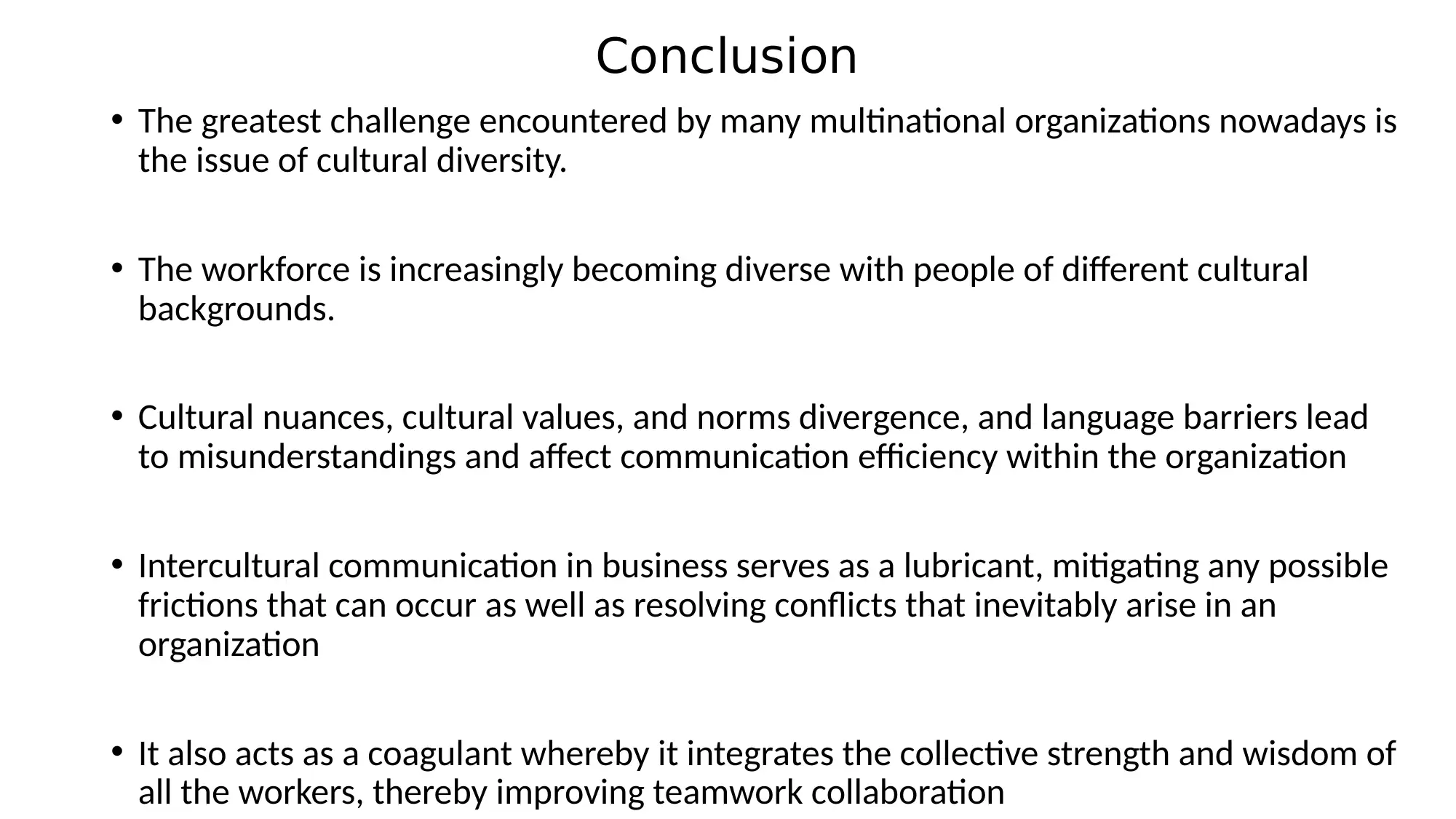
Conclusion
• The greatest challenge encountered by many multinational organizations nowadays is
the issue of cultural diversity.
• The workforce is increasingly becoming diverse with people of different cultural
backgrounds.
• Cultural nuances, cultural values, and norms divergence, and language barriers lead
to misunderstandings and affect communication efficiency within the organization
• Intercultural communication in business serves as a lubricant, mitigating any possible
frictions that can occur as well as resolving conflicts that inevitably arise in an
organization
• It also acts as a coagulant whereby it integrates the collective strength and wisdom of
all the workers, thereby improving teamwork collaboration
• The greatest challenge encountered by many multinational organizations nowadays is
the issue of cultural diversity.
• The workforce is increasingly becoming diverse with people of different cultural
backgrounds.
• Cultural nuances, cultural values, and norms divergence, and language barriers lead
to misunderstandings and affect communication efficiency within the organization
• Intercultural communication in business serves as a lubricant, mitigating any possible
frictions that can occur as well as resolving conflicts that inevitably arise in an
organization
• It also acts as a coagulant whereby it integrates the collective strength and wisdom of
all the workers, thereby improving teamwork collaboration
Paraphrase This Document
Need a fresh take? Get an instant paraphrase of this document with our AI Paraphraser
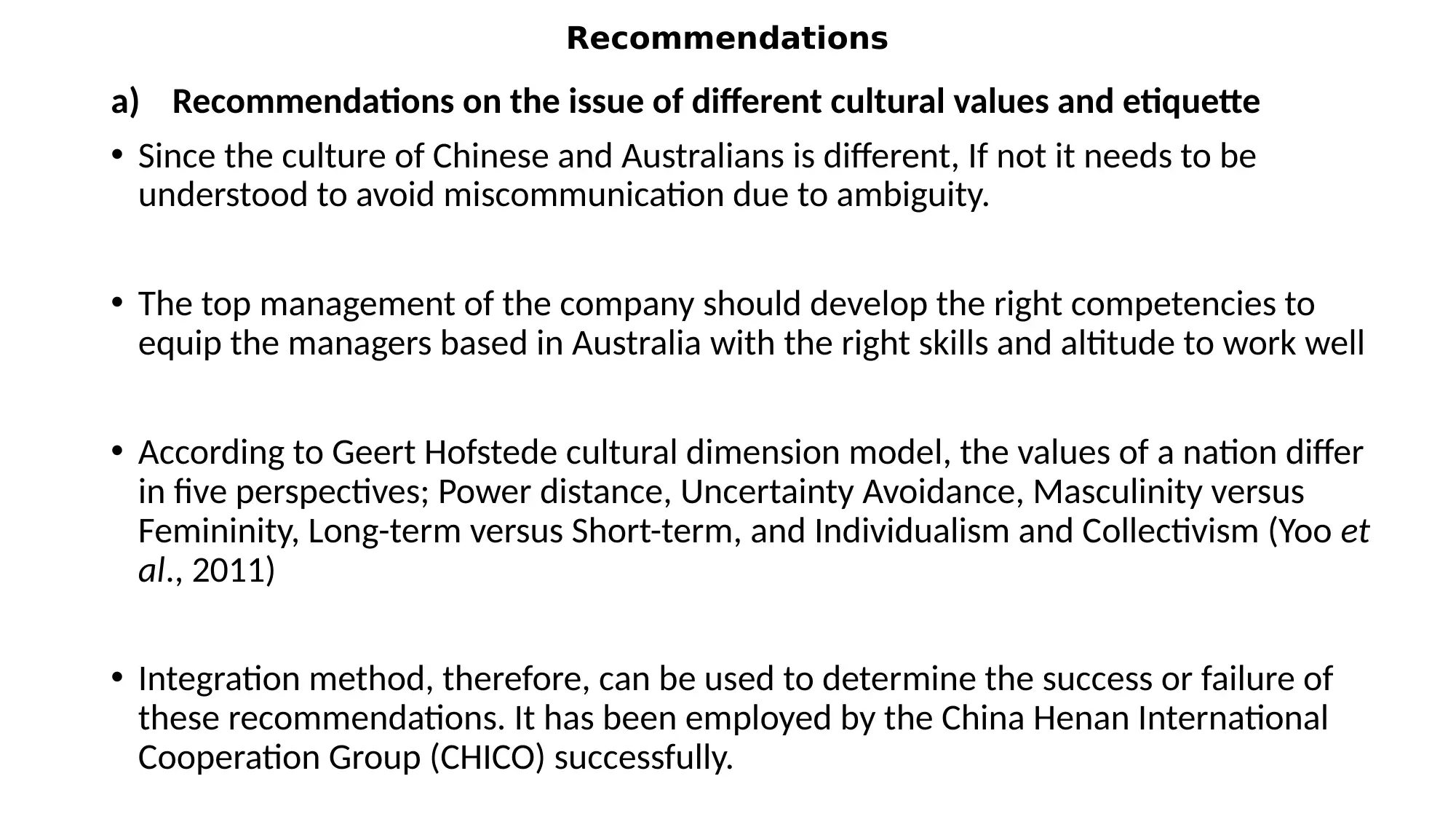
Recommendations
a) Recommendations on the issue of different cultural values and etiquette
• Since the culture of Chinese and Australians is different, If not it needs to be
understood to avoid miscommunication due to ambiguity.
• The top management of the company should develop the right competencies to
equip the managers based in Australia with the right skills and altitude to work well
• According to Geert Hofstede cultural dimension model, the values of a nation differ
in five perspectives; Power distance, Uncertainty Avoidance, Masculinity versus
Femininity, Long-term versus Short-term, and Individualism and Collectivism (Yoo et
al., 2011)
• Integration method, therefore, can be used to determine the success or failure of
these recommendations. It has been employed by the China Henan International
Cooperation Group (CHICO) successfully.
a) Recommendations on the issue of different cultural values and etiquette
• Since the culture of Chinese and Australians is different, If not it needs to be
understood to avoid miscommunication due to ambiguity.
• The top management of the company should develop the right competencies to
equip the managers based in Australia with the right skills and altitude to work well
• According to Geert Hofstede cultural dimension model, the values of a nation differ
in five perspectives; Power distance, Uncertainty Avoidance, Masculinity versus
Femininity, Long-term versus Short-term, and Individualism and Collectivism (Yoo et
al., 2011)
• Integration method, therefore, can be used to determine the success or failure of
these recommendations. It has been employed by the China Henan International
Cooperation Group (CHICO) successfully.
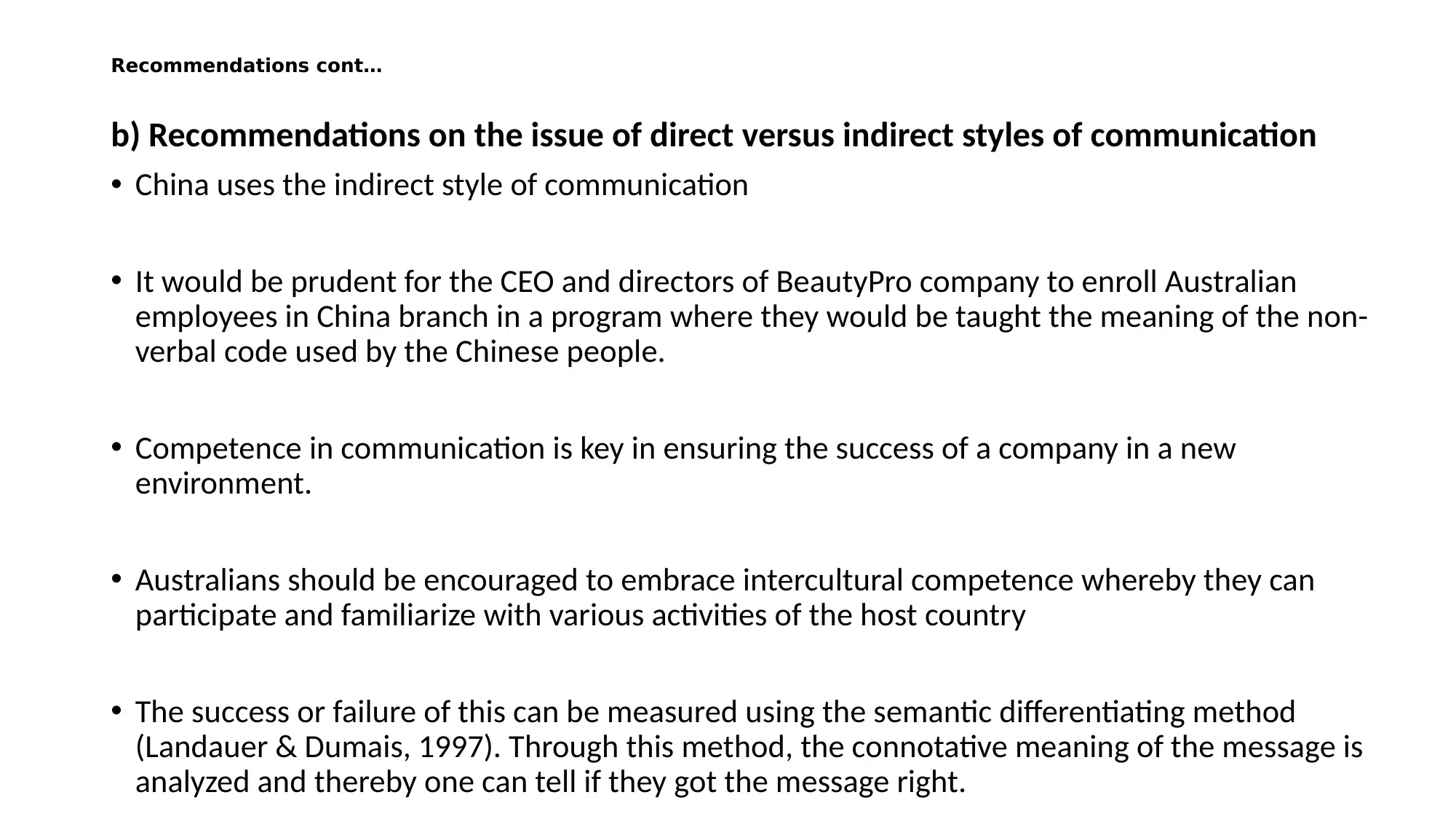
Recommendations cont…
b) Recommendations on the issue of direct versus indirect styles of communication
• China uses the indirect style of communication
• It would be prudent for the CEO and directors of BeautyPro company to enroll Australian
employees in China branch in a program where they would be taught the meaning of the non-
verbal code used by the Chinese people.
• Competence in communication is key in ensuring the success of a company in a new
environment.
• Australians should be encouraged to embrace intercultural competence whereby they can
participate and familiarize with various activities of the host country
• The success or failure of this can be measured using the semantic differentiating method
(Landauer & Dumais, 1997). Through this method, the connotative meaning of the message is
analyzed and thereby one can tell if they got the message right.
b) Recommendations on the issue of direct versus indirect styles of communication
• China uses the indirect style of communication
• It would be prudent for the CEO and directors of BeautyPro company to enroll Australian
employees in China branch in a program where they would be taught the meaning of the non-
verbal code used by the Chinese people.
• Competence in communication is key in ensuring the success of a company in a new
environment.
• Australians should be encouraged to embrace intercultural competence whereby they can
participate and familiarize with various activities of the host country
• The success or failure of this can be measured using the semantic differentiating method
(Landauer & Dumais, 1997). Through this method, the connotative meaning of the message is
analyzed and thereby one can tell if they got the message right.
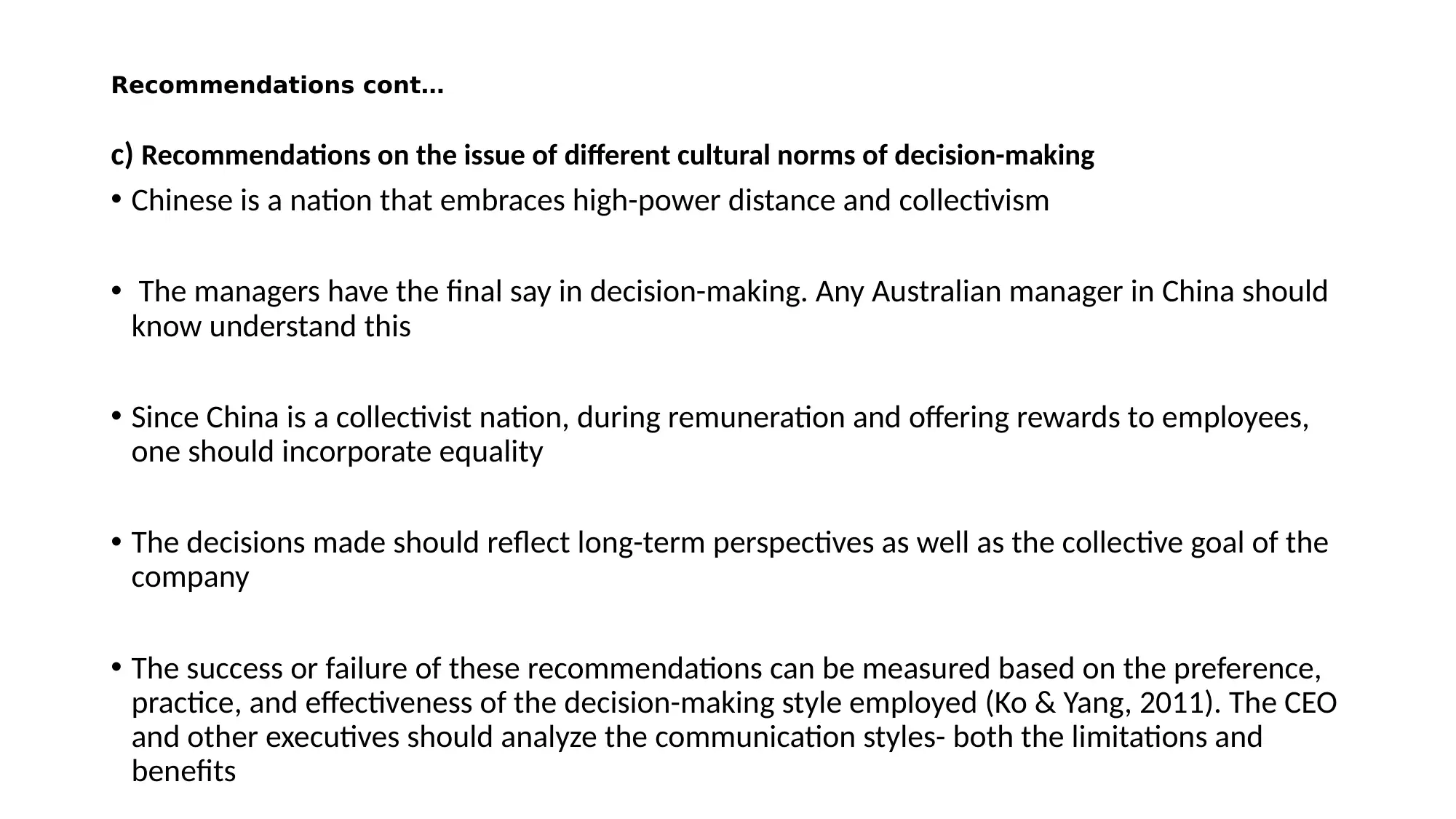
Recommendations cont…
c) Recommendations on the issue of different cultural norms of decision-making
• Chinese is a nation that embraces high-power distance and collectivism
• The managers have the final say in decision-making. Any Australian manager in China should
know understand this
• Since China is a collectivist nation, during remuneration and offering rewards to employees,
one should incorporate equality
• The decisions made should reflect long-term perspectives as well as the collective goal of the
company
• The success or failure of these recommendations can be measured based on the preference,
practice, and effectiveness of the decision-making style employed (Ko & Yang, 2011). The CEO
and other executives should analyze the communication styles- both the limitations and
benefits
c) Recommendations on the issue of different cultural norms of decision-making
• Chinese is a nation that embraces high-power distance and collectivism
• The managers have the final say in decision-making. Any Australian manager in China should
know understand this
• Since China is a collectivist nation, during remuneration and offering rewards to employees,
one should incorporate equality
• The decisions made should reflect long-term perspectives as well as the collective goal of the
company
• The success or failure of these recommendations can be measured based on the preference,
practice, and effectiveness of the decision-making style employed (Ko & Yang, 2011). The CEO
and other executives should analyze the communication styles- both the limitations and
benefits
Secure Best Marks with AI Grader
Need help grading? Try our AI Grader for instant feedback on your assignments.
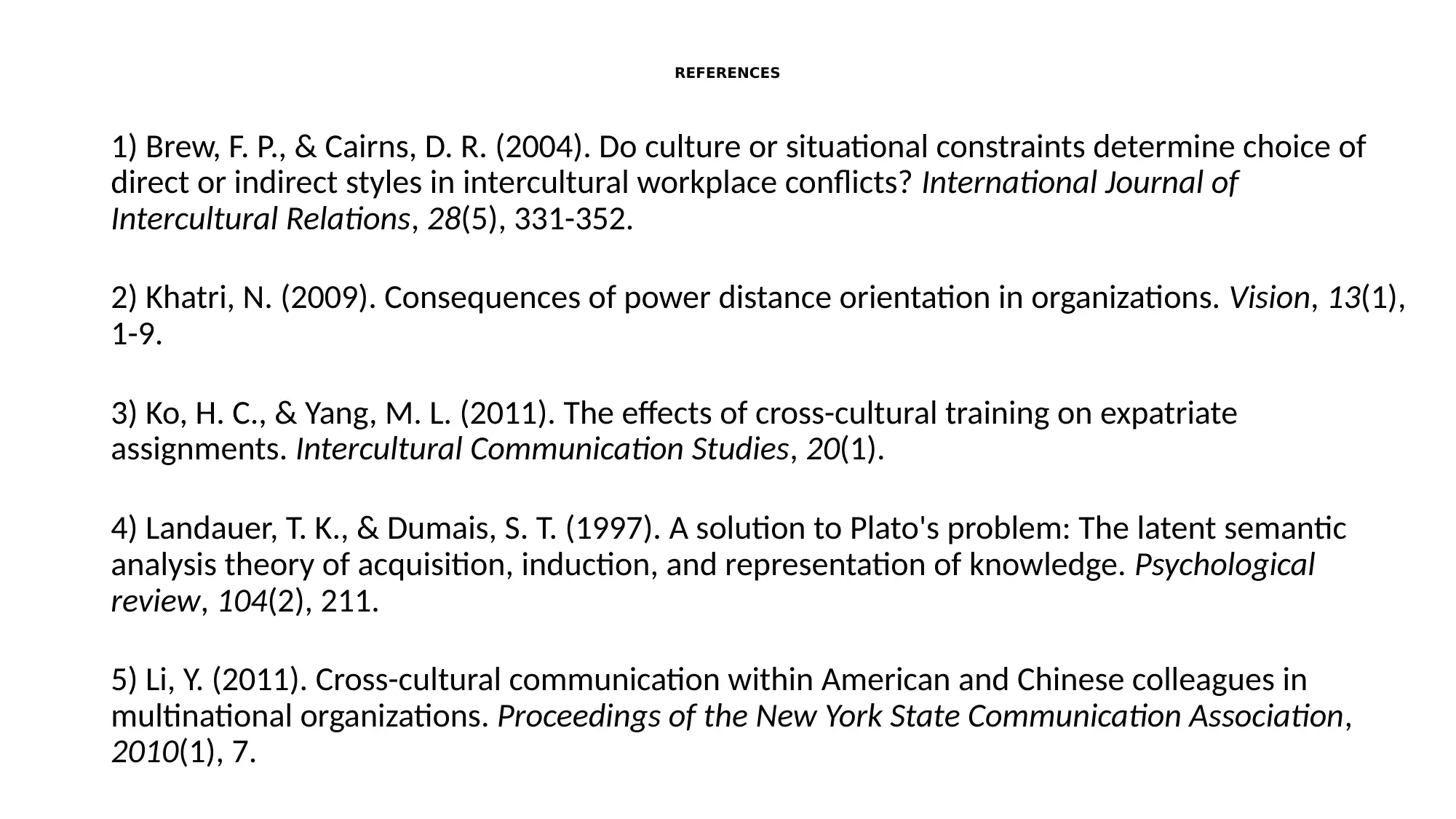
REFERENCES
1) Brew, F. P., & Cairns, D. R. (2004). Do culture or situational constraints determine choice of
direct or indirect styles in intercultural workplace conflicts? International Journal of
Intercultural Relations, 28(5), 331-352.
2) Khatri, N. (2009). Consequences of power distance orientation in organizations. Vision, 13(1),
1-9.
3) Ko, H. C., & Yang, M. L. (2011). The effects of cross-cultural training on expatriate
assignments. Intercultural Communication Studies, 20(1).
4) Landauer, T. K., & Dumais, S. T. (1997). A solution to Plato's problem: The latent semantic
analysis theory of acquisition, induction, and representation of knowledge. Psychological
review, 104(2), 211.
5) Li, Y. (2011). Cross-cultural communication within American and Chinese colleagues in
multinational organizations. Proceedings of the New York State Communication Association,
2010(1), 7.
1) Brew, F. P., & Cairns, D. R. (2004). Do culture or situational constraints determine choice of
direct or indirect styles in intercultural workplace conflicts? International Journal of
Intercultural Relations, 28(5), 331-352.
2) Khatri, N. (2009). Consequences of power distance orientation in organizations. Vision, 13(1),
1-9.
3) Ko, H. C., & Yang, M. L. (2011). The effects of cross-cultural training on expatriate
assignments. Intercultural Communication Studies, 20(1).
4) Landauer, T. K., & Dumais, S. T. (1997). A solution to Plato's problem: The latent semantic
analysis theory of acquisition, induction, and representation of knowledge. Psychological
review, 104(2), 211.
5) Li, Y. (2011). Cross-cultural communication within American and Chinese colleagues in
multinational organizations. Proceedings of the New York State Communication Association,
2010(1), 7.
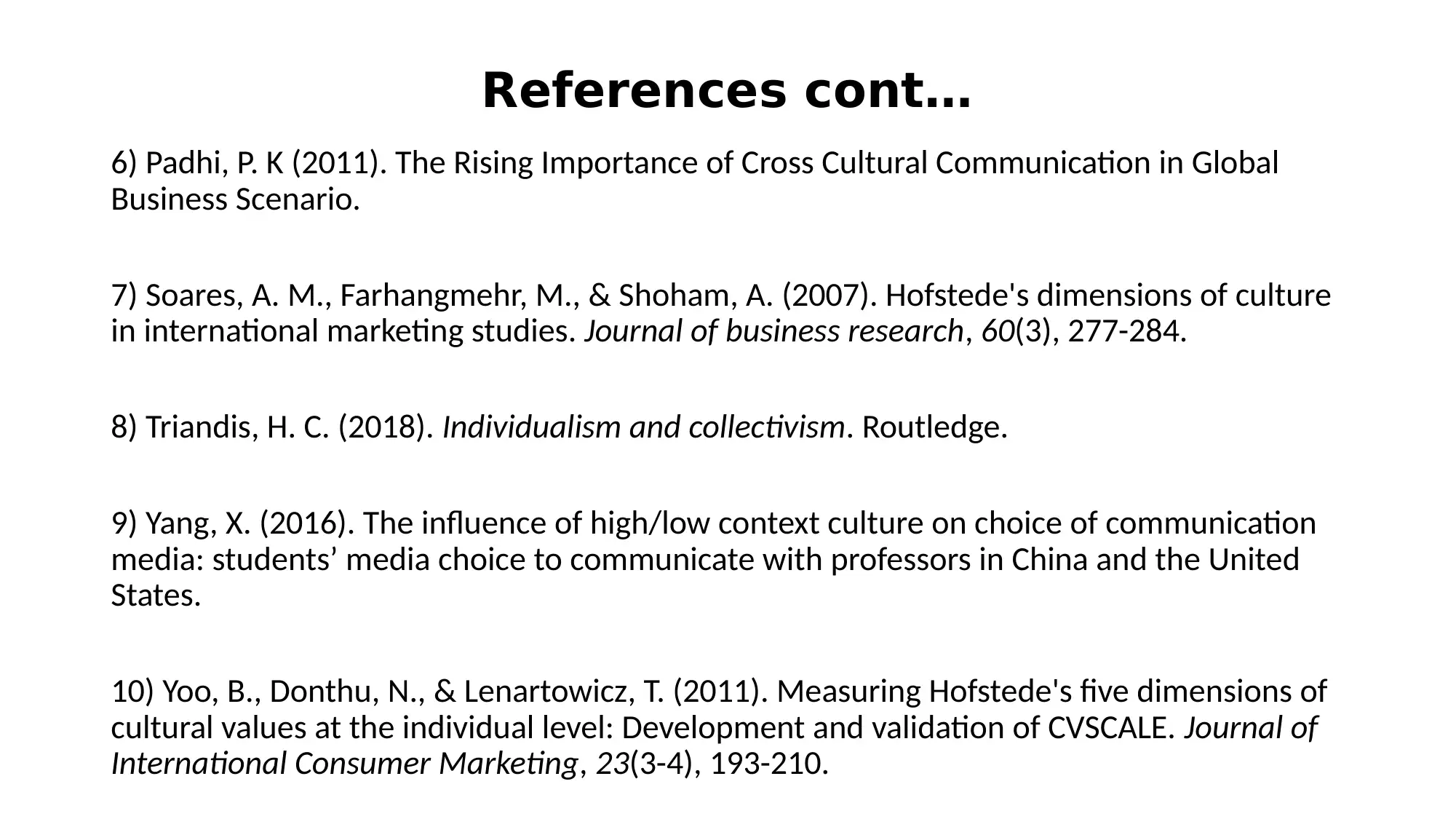
References cont…
6) Padhi, P. K (2011). The Rising Importance of Cross Cultural Communication in Global
Business Scenario.
7) Soares, A. M., Farhangmehr, M., & Shoham, A. (2007). Hofstede's dimensions of culture
in international marketing studies. Journal of business research, 60(3), 277-284.
8) Triandis, H. C. (2018). Individualism and collectivism. Routledge.
9) Yang, X. (2016). The influence of high/low context culture on choice of communication
media: students’ media choice to communicate with professors in China and the United
States.
10) Yoo, B., Donthu, N., & Lenartowicz, T. (2011). Measuring Hofstede's five dimensions of
cultural values at the individual level: Development and validation of CVSCALE. Journal of
International Consumer Marketing, 23(3-4), 193-210.
6) Padhi, P. K (2011). The Rising Importance of Cross Cultural Communication in Global
Business Scenario.
7) Soares, A. M., Farhangmehr, M., & Shoham, A. (2007). Hofstede's dimensions of culture
in international marketing studies. Journal of business research, 60(3), 277-284.
8) Triandis, H. C. (2018). Individualism and collectivism. Routledge.
9) Yang, X. (2016). The influence of high/low context culture on choice of communication
media: students’ media choice to communicate with professors in China and the United
States.
10) Yoo, B., Donthu, N., & Lenartowicz, T. (2011). Measuring Hofstede's five dimensions of
cultural values at the individual level: Development and validation of CVSCALE. Journal of
International Consumer Marketing, 23(3-4), 193-210.

Questions Are
Welcomed
Welcomed
Paraphrase This Document
Need a fresh take? Get an instant paraphrase of this document with our AI Paraphraser

Thank you!
1 out of 14
Related Documents
Your All-in-One AI-Powered Toolkit for Academic Success.
+13062052269
info@desklib.com
Available 24*7 on WhatsApp / Email
![[object Object]](/_next/static/media/star-bottom.7253800d.svg)
Unlock your academic potential
© 2024 | Zucol Services PVT LTD | All rights reserved.




